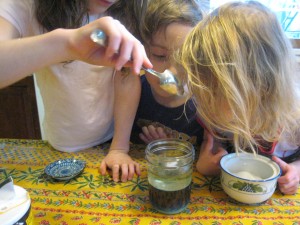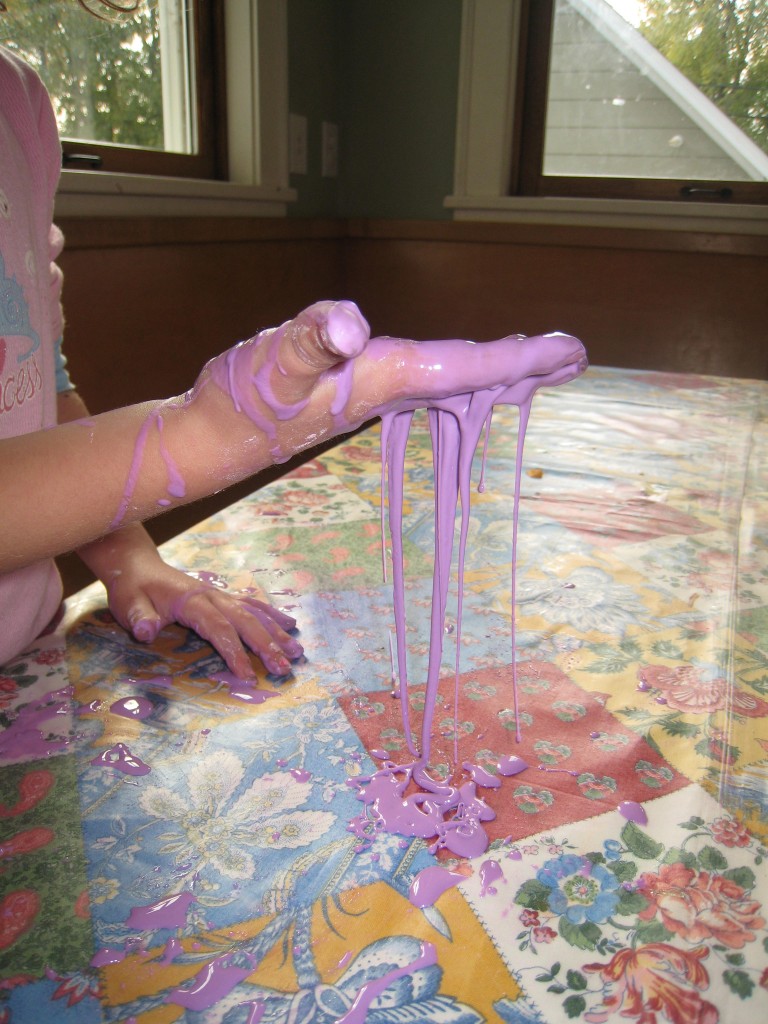Category:Chemistry Experiments’
Sweet (and Salty) Lava Lamps
- by KitchenPantryScientist
Pull out a jar, a bottle of vegetable oil, some food coloring, salt, sugar, and water to mix up this easy experiment! 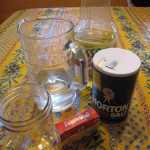
Fill the jar about halfway up with water and add a few drops of food coloring for contrast. Add about half as much vegetable oil to the jar and watch it float to the top. Now, a spoonful at a time, add salt to the jar. The salt will pull some of the oil down with it, but will release the oil as it dissolves and the oil will float back to the top. This will make your science experiment look like a real lava lamp. Keep adding salt to make it keep working. Now, try adding sugar or even sand. Kosher salt worked really well!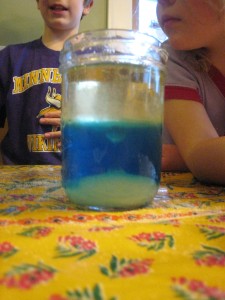
What worked the best for you? Do you know why oil floats to the top of the water? Email me your answers in the comments section of this post for a chance to win a KITCHENPANTRYSCIENTIST.COM tee shirt (size M.) I’ll do a drawing for a winner in two weeks! Thanks to PBSkids/DragonflyTV’s website for this fun idea. Check out their website for more great kids’ science!
Invisible Ink
- by KitchenPantryScientist
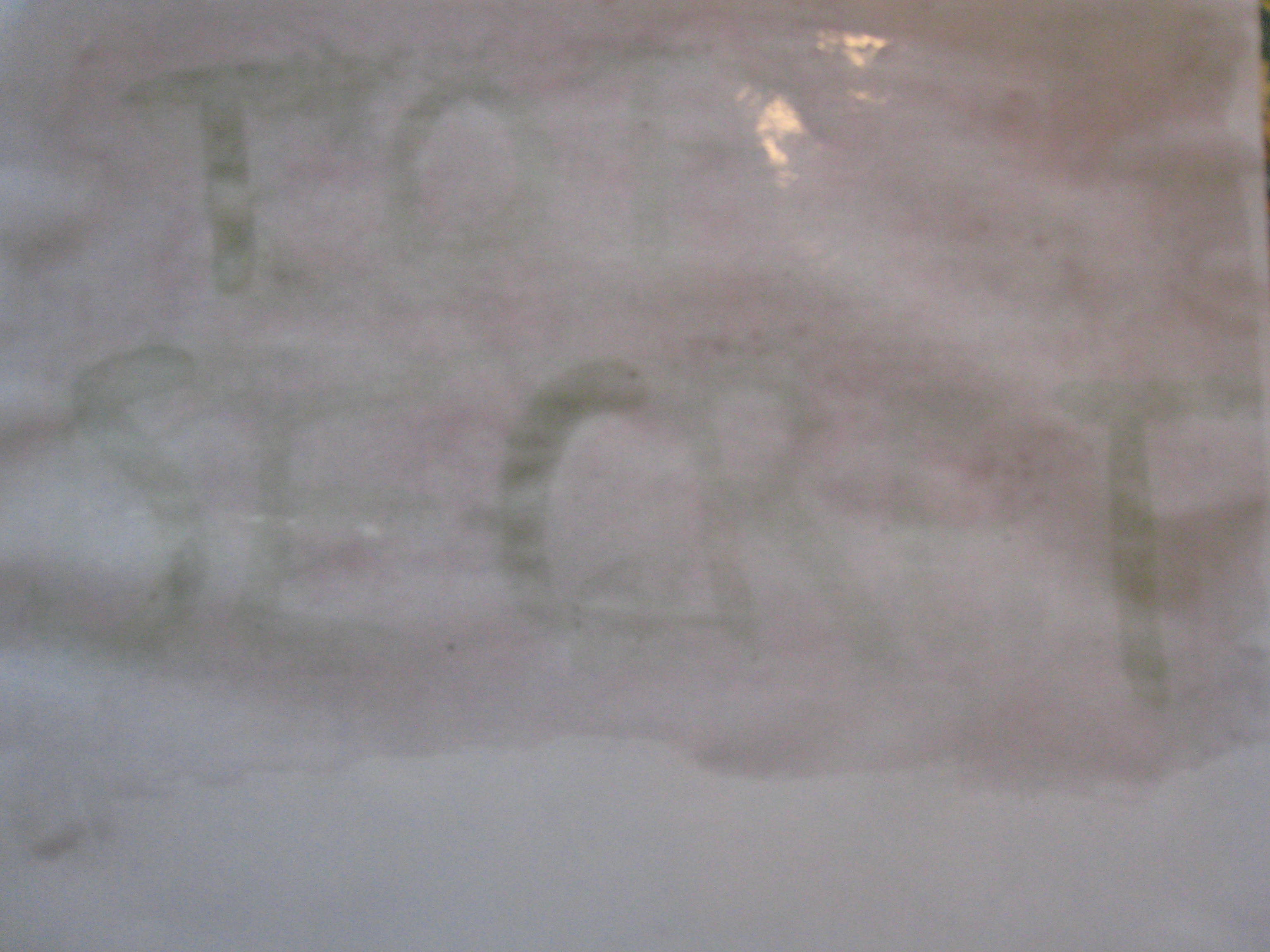
My kids love to play spy games. They spy on us, they spy on each other. They write notes in code and hide them all over the house. I knew right away that they would have fun with this science project. There’s definately enough 9-year old girl left in me to think it’s really cool too! This is a project that kids can actually do IN their science notebooks (or, they can just tape their note into the notebook when it is dry.) Like most projects, it doesn’t work perfectly. However, it is fun and you will see a message appear although it may be fuzzy.
All you need is paper, water, baking soda and grape juice. Simply add a few big spoonfuls of baking soda to a cup of water and mix it well (I heated the solution in the microwave to warm it in an attempt to dissolve more of the soda.) Dip a paint brush in the mixture and write a message or draw a picture on your paper. Let the paper dry completely.

When you are ready to reveal the secret code, have them paint over the paper with grape juice. Don’t use to much, or it will be a sloppy mess. The grape juice will react with the baking soda on the paper,changing the acidity of the grape juice and causing the words to appear a little darker than the background of the regular juice. Ours turned green. You could also try some different types of juice to see what happens. Have your kids record their results in their science notebooks! If they are interested, have them look up the definition for acid and base on a science website like chemistry.about.com. 
The words weren’t very clear, but it was still a fun project and my kids loved it. Maybe your kids can perfect the technique. After all, trouble-shooting is a great life skill.
Growing Crystals
- by KitchenPantryScientist
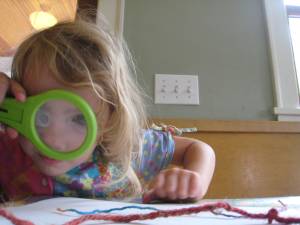
Patience is tough for kids, especially in today’s world of instant gratification. In this experiment, your kids will put a string in some colored salt water and watch and wait for crystals to grow. The crystals aren’t huge and spectacular, but your child can see them and a magnifying glass makes them easier to inspect.
All you’ll need is a clear container or containers, water, salt, food coloring and string. We used both kitchen twine and jute twine to see what would happen. The white kitchen twine worked best.
First, have your child put a few drops of food coloring in the container(s) that you are using. Then, have them cut a piece of string about six inches long. It doesn’t have to be exact. Help your child tie a knot or two at each end of the string.
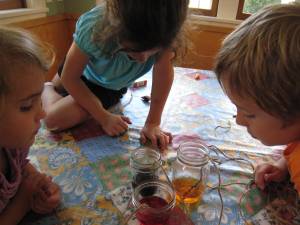
Boil some water (a cup or two) and, when it is boiling, start adding salt to the water. Add a tablespoon at a time, stirring the mixture to dissolve the salt. Do this until no more salt will dissolve (you’ll see salt and it won’t go away no matter how much or how long you stir.) At this point, you can let the mixture cool a little so it’s not dangerously hot.
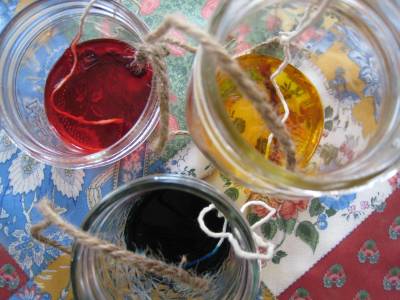
When cool, pour an eighth cup or so of the salt solution you’ve made into the container(s) containing food coloring. Let your child mix it and then have them place one end of the string into the colored salt solution. They may have to swish it around to get it to soak up the salt water since the string will want to float. Leave the other end of the string hanging over the edge of the container.
As the water evaporates, the salt that the string has absorbed will remain in the fibers on the string and form new, larger crystals on the string. Have your child check the string every day and, if they want to, record the results in their science notebooks. It may take several days before the water evaporates and the salt crystals form – it took ours five days to evaporate. Try not to let the end of the string that hangs over the edge of the jar or glass touch the counter, or the salt water will be wicked onto the countertop. As I said before, a magnifying glass is a fantastic way to look at the crystals that form on the string. Ask your child what shape the crystal are-cubes, spikes? What do they see? If they’re interested, have them draw the crystals and record their observations.
There are great books on crystals and gems at the library. Check them out!
Apples and Acids
- by KitchenPantryScientist
One thing I love about doing science with kids is that, regardless of their age, they can participate and enjoy it at some level. This is a perfect example. Even younger children will have fun putting apple slices into cups and watching what happens. Older children can make hypothesis (educated guesses) about what will happen and try to draw conclusions about what happened. I’ll do my best to make it simple to do and easy to understand!
Apples turn brown when they’re cut open and exposed to air. This is the result of oxygen in the air reacting with enzymes and other chemical compounds in the apples. We’re going to observe what happens when you treat apple slices with acids (lemon juice and vinegar) and a base (baking soda and water). We will also watch how fast treated apple slices turn brown compared to an untreated apple slice!
You could ask your child to choose one of the following hypothesis: 1. A solution with acid in it will stop the apples from turning brown so fast. or 2. A solution with acid in it will not change how fast the apples turn brown. Older kids could write their hypothesis in their notebooks!
Materials: an apple, vinegar (white or apple cider), lemon juice, baking soda, water, five clear containers (plastic cups or glasses) labeled as follows: no treatment, water, baking soda, lemon juice, vinegar.
Mix together about 1/2 tsp of baking soda in 1/4 cup water. Add it to the appropriate container. To another container, add 1/4 cup vinegar, to another add 1/4 cup water and to another add 1/4 cup lemon juice. Leave one cup empty for your “no treatment” apple, or the one just exposed to air. Your child can help you do this! Make sure small children don’t rub or splash vinegar or lemon juice in their eyes. Remember, they’re acids! Explain to them that lemon juice and vinager are acids and baking soda makes a basic solution. Water is pretty neutral (neither an acid or a base.) If they want to know more about acids and bases, go to http://library.thinkquest.org/J001539/
Slice the apple and immediately have your child add a slice to each cup, thoroughly coating the apple slices with solution. Pour the solutions out, leaving the apple slices in the cups. Help your child write down or draw how the slices look. They can make a table in their lab notebook to record their observations, with treatment in one column next to appearance in the next column (save room for more columns to note appearance over time.) I had to cover our cups loosely with foil due to the frightening number of fruit flies that have recently invaded my kitchen.
Have them observe the slices in a few hours and over the next few days, recording their observations if they want to . They may want to draw how the slices look over time, or even take pictures for their science notebooks.
Finally, have them draw a conclusion from their observations (data) and record it in their notebook if they want to. Did the solutions keep the apples from turning brown? Was their hypothesis correct? Which solutions worked best? Did both acids (lemon juice and vinegar) help preserve the color? If not, does this suggest that it was something else in the solution, and not just the acid that preserved the color? What did the water do? The base?
You can make it as simple or complicated as you want to! Just make it fun and don’t take over. Let your kids get their hands dirty!
Cornstarch Goo-Liquid or Solid?
- by KitchenPantryScientist
This experiment is easy, non-toxic and so much fun that it is worth every bit of the mess it makes. Your kids will love it!
All you need is a cup of cornstarch and half a cup of water with a little food coloring in it (purple and green and red would be gross!) Mix the two ingredients to a medium-size bowl with a spoon or your fingers. The goo should be the consistency of syrup.
Now, play with the mixture! You will discover that it behaves like a solid when you agitate it, or move it quickly, and like a liquid when you let it sit still. Pour some onto plates or into bowls if you want to. We poured it directly onto our table which was pretty messy, but lots of fun! Hold a handful on your palm and watch it drip between your fingers! Roll it into a ball. If it gets too dry, just add a little more water. You can easily clean the goo off of flat surfaces using a plastic spatula. Wash it off hands with water.
Cornstarch molecules are like long ropes. When you leave them alone, or move them slowly, they can slide past each other and look like a liquid. However, if you squeeze them, stir them or roll them around in your hands, the ropey molecules look and feel more like a solid. Materials like cornstarch goo are known as non-Newtonian fluids, since they don’t have the normal properties of either a liquid or a solid.
Click here to watch my video on how to make cornstarch goo.
